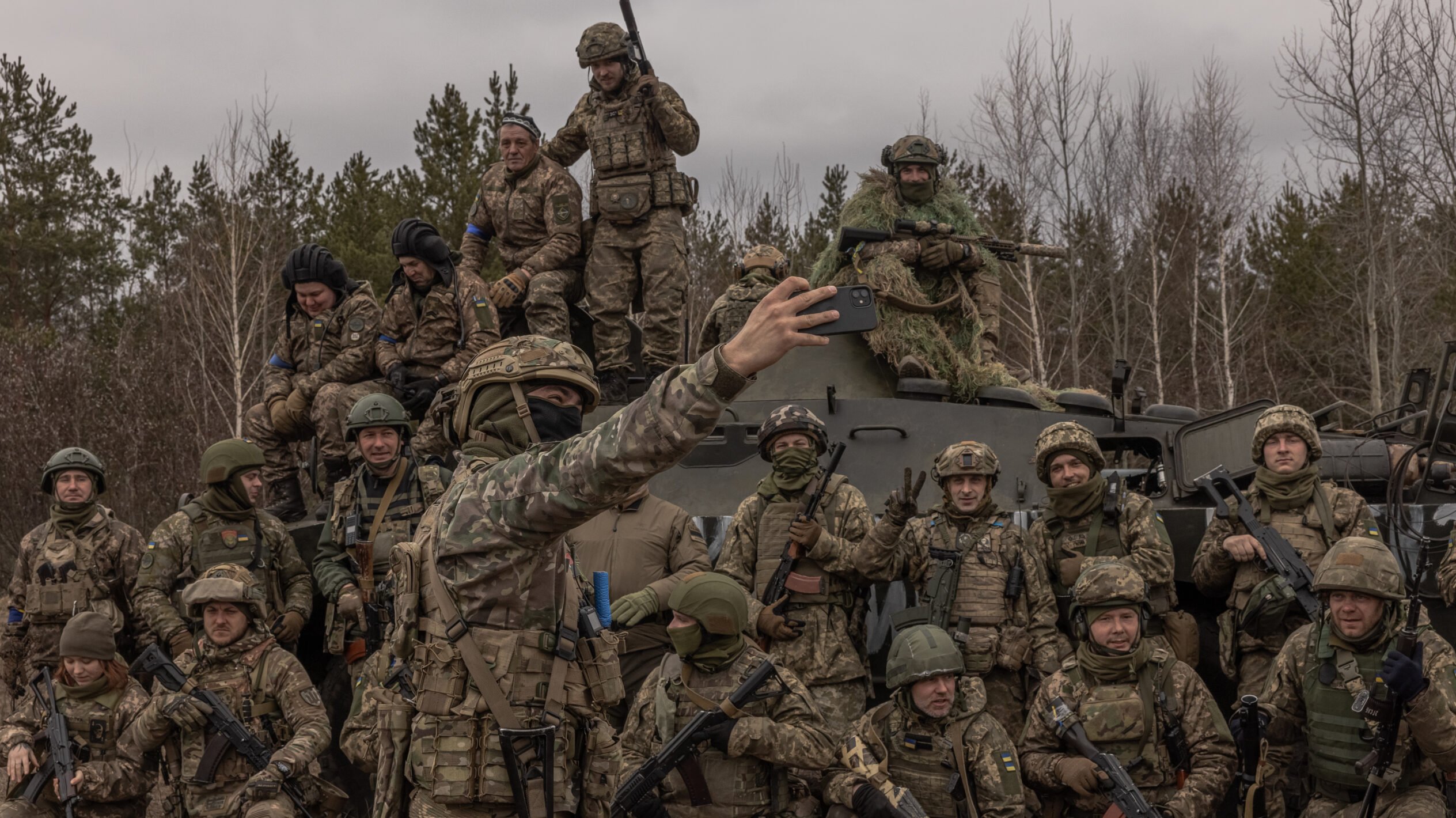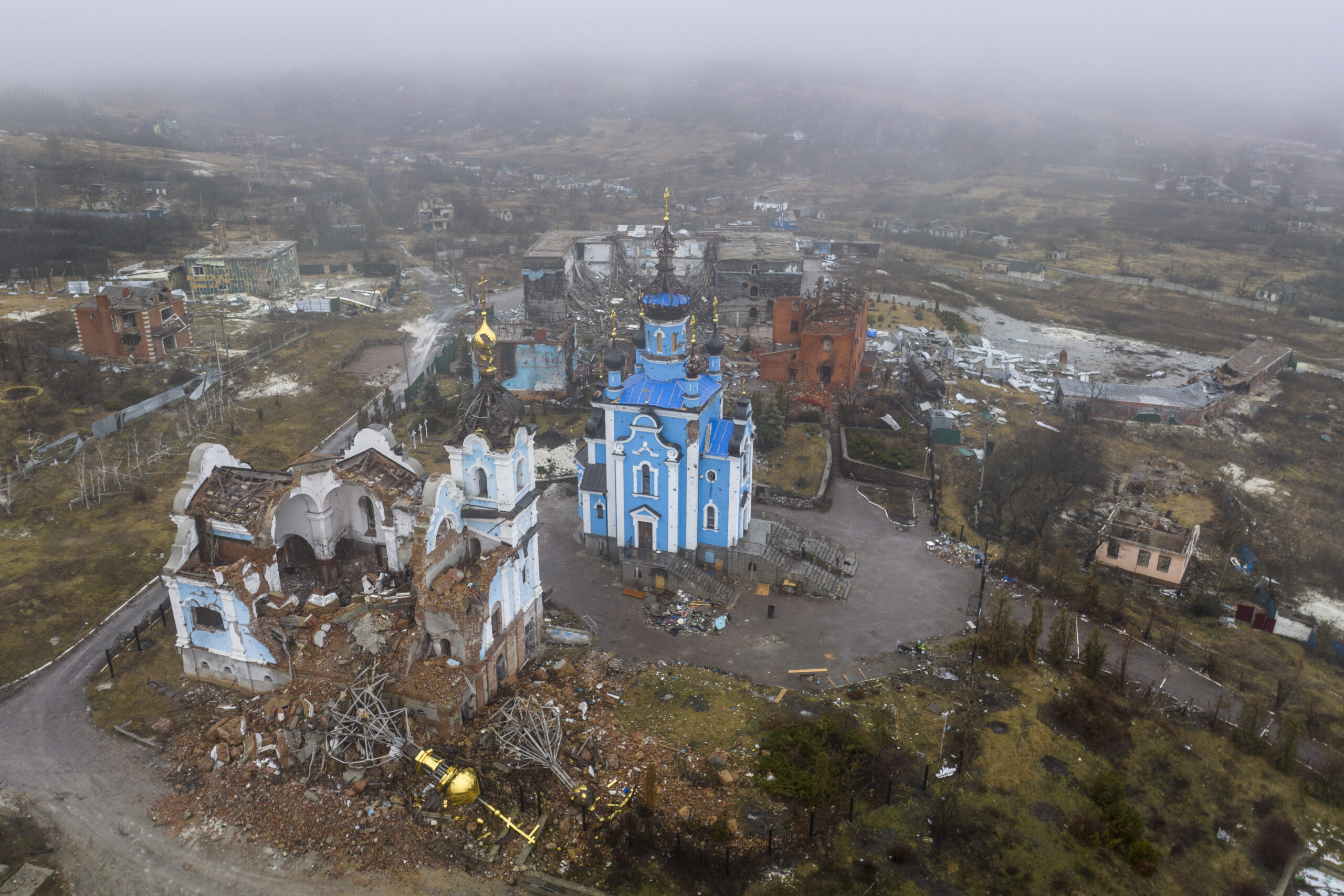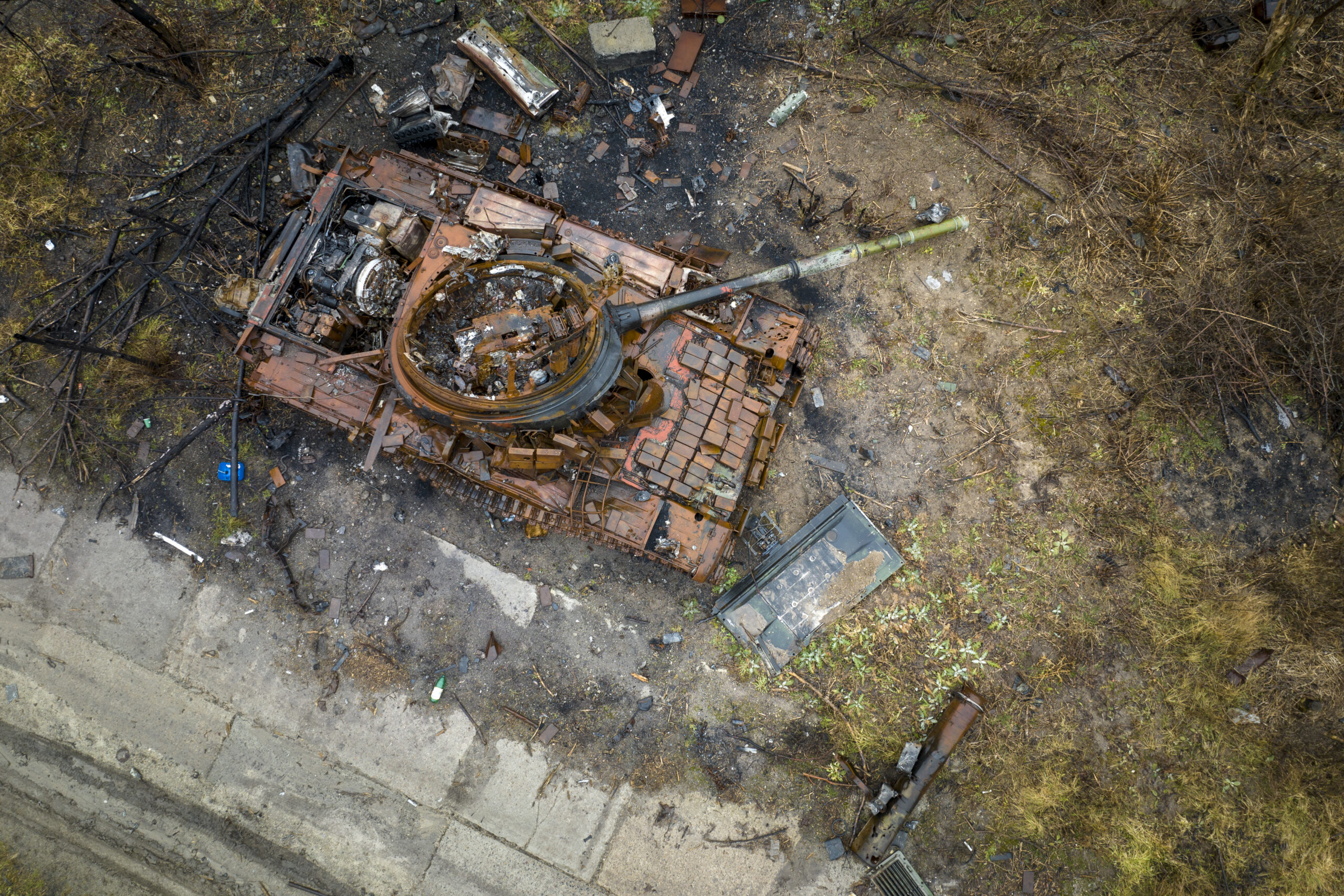
Members of Ukraine’s Territorial Defense Forces pose for photos during their military training on February 27, 2023 near Chernobyl, Ukraine. Russia’s large-scale assault on Ukraine has entered its second year, with the fiercest fighting concentrated in the country’s east and south. (Roman Pilipey/Getty Images)
WARSAW — When Russian forces first crossed Ukraine’s borders on Feb. 24 2022, there were few who believed Kyiv would last even a week, let alone have any chance against Russia’s overwhelming military. And yet, when US President Joe Biden made a surprise and morale-building visit to Kyiv on Feb. 20, he did so with a startlingly different assessment than defense planners would have given him a year ago.
A day later, at an address to the public in the Polish capitol’s Royal Castle, the American president said flatly “brutality will never grind down the will of a free Ukraine. Ukraine will never be a victory for Russia. Never.”
There are still major questions about the way forward for Ukraine, one year into the war. But discussions among analysts and defense officials, speaking both to Breaking Defense and in public appearances over the last month, have become more optimistic that Ukraine could make gains come the spring. This is due, in no small measure, to the deliveries by the US and others to Kyiv of a steady stream of advanced weapon systems.
Nothing is certain, but if Ukraine is to win, there does now appear to be a roadmap forward — and, some say, those gains could be big enough to cause a fracturing in Moscow that would force Russian president Vladimir Putin to reverse course.
Three Phases: Maintaining Momentum
Sustaining this level of offensive capability and continuing to degrade Putin’s military depends on Ukraine continuing to receive a relentless flow of arms and munitions from the 54 nations that are part of the Ukraine Defense Contact Group. There appears to be a consensus among those members to continuously “up the ante” — providing progressively more sophisticated and longer-range weaponry that has permitted the Ukrainians to achieve technological surprise over the Russian armed forces.
Speaking last week in Munich at a special event on Ukraine sponsored by the Viktor Pinchuk Foundation, retired US General and former CIA Director David Petraeus outlined the basic requirements for Ukraine’s military that the US and its partners need to keep supplying for, in the words of Biden, “as long as it takes.” He provided details on the three phases that constitute the war from here on in, dividing them into near-term, medium-term and long-term and the requirements that each phase will demand.
In the near-term the reality is that — despite the months of shipments of weapons and hardware that have made such a difference on the battlefield — “Ukraine still does not yet have all that it needs,” Petraeus explained. There continues to be great demand for “more ammo, more precision munitions, spare parts and additional air defense capacities” in order to hold back the anticipated late February-early March Russian offensive.
More Breaking Defense Coverage marking one year of war in Ukraine:
- What Pentagon leaders say they have learned from a year of battle in Ukraine
- A year into Ukraine, looking back at 5 prewar predictions
- Naval warfare poised to play smaller role in year 2 of Ukraine war
- At Munich Conference, Ukraine drives an unusual focus on acquisition over policy
- Israel reconsidering whether to send weapons to Ukraine: Sources
- Marking 1 year of Ukraine war, US pledges $2B in weapons, including new drone types
- Polish Leopard 2 tanks arrive in Ukraine as Sweden announces more to come
Though not highlighted specifically by Petraeus, one of the weapons Ukraine could use more of is the M142 HIMARS rocket artillery. The system has been credited as responsible for 70 percent of the advances and successful engagements by the Ukrainian military in the battles around the southern city of Kherson alone. Russian forces were eventually forced to withdraw and admit defeat.
The US military has been buoyed by the success of this system and other weapons they were responsible for funding industry to design and deliver. Due to the success of HIMARS, “the Army has been strutting through the Pentagon,” one Pentagon source said. “There are a lot of ‘I told you so’ comments being made these days.”
In the medium term, which Petraeus estimated to be approximately around June, “this is where the new tanks come in, the infantry fighting vehicles plus longer-range strike systems. More importantly will be the Ukrainian troops now training in Germany and other European nations.” These new troops plus the Leopard tanks and the other new weaponry “will achieve combined arms effects and this will crack the Russian forces in the south.”
Long-term, he continued, will include “the time to get on with training Ukrainian pilots on the F-16s or Eurofighters. But more importantly training of the people who will sustain and service them. Then it is also time for the long-range ATACMS” to be brought into the fight, a reference to the US-made artillery weapon that, to this point, the White House has declined to provide Ukraine.
Significant attention is already being brought to bear on the issue of F-16s to be sent to Ukraine, with it becoming the latest example of Ukraine’s leadership using calls to action to rile up public support. As an anecdotal example, during Biden’s visit to Warsaw, a small demonstration was held within earshot of the downtown Marriott hotel where the Biden contingent was staying.
Once those three phases — the timetable on when the conclusion might be was left ambiguous — have happened, Petraeus predicted, comes an altogether different kind of challenge.
“There will have to be the implementation of a Marshal Plan-type rebuilding of Ukraine,” said Petraeus. “But this cannot happen without an ironclad security guarantee. That means either NATO membership or multilateral agreement between Ukraine and the US plus other nations that comprise some coalition of the willing.”
Realizations of Failure
Another member of the panel at the same event, the Pulitzer-Prize winning historian Anne Applebaum, told the audience that there is a “statement of realism that the war will end when and only when the Russians realize it was a mistake to begin with.”
“I mean really end,” she emphasized, “and not some frozen conflict. What we need is a change of thinking in Moscow. This will come as the result of a Ukrainian victory. I do not care if this change comes about because Putin wakes up one morning with this realization or if it is because he falls down a flight of stairs. I do not care, but Ukrainian victory probably also means the return of Crimea.”
At the moment Putin shows no such signs of thinking needs to develop an exit strategy. On Feb. 22, the former KGB Lt. Col. held a massive rally at Moscow’s Luzhniki stadium to call for unity and victory and with giant screens showing massive destruction of buildings by bombardment in Ukraine. Victory, he declared, is being achieved on all fronts.
In a macabre moment, a revamped version of the famous World War II patriotic song “Katyusha” was performed by an Army officer who had composed new lyrics that include the phrase “I’m not afraid to stain my hands in blood up to the elbow.”

As seen from an aerial view, an Orthodox church stands in ruins on February 27, 2023 in Bogorodychne, in the Donbas region of eastern Ukraine. The church grounds had reportedly been used as a headquarters for occupying Russian forces and was the scene of intense fighting with Ukrainian troops, who liberated the town last fall. The ruined community has been completely abandoned. (John Moore/Getty Images)
Missing were any of the unhappy facts of the Russian military’s performance in this war, such as the catastrophically high casualty rates or the chronic undersupply problems in the field.
One of the unreported events is the story behind the massive losses in battles in the Eastern Donbas region, where Russian forces are making advances at what has reportedly been an obscene human cost. Ukrainian volunteers who spoke to Breaking Defense by phone told of entire Russian units being given doses of powerful narcotics before being sent into battle. (Breaking Defense could not independently verify the statements.)
“These soldiers are so hopped up as to be unaware of what is happening. They do not even see or discern the man next to them being shot,” said Petro, a volunteer ferrying supplies and vehicles into the city of Bakhmut. “This is why you see these [surveillance drone] videos of these Russian soldiers literally walking into machine-gun fire like a zombie army.”
Other stories are of Russian servicemen going into battle with no assault rifles or any weapons other than a lanyard full of grenades, essentially making them suicide bombers. “And it is always a one-way mission for them,” said Petro.
None of these unpleasant vignettes were included in the presentation given by Putin at his grandiose Moscow rally. Neither was the fact that were not enough people who showed up of their own volition to make for a standing room-only crowd. In order to create a false illusion of the war’s popularity, the stadium was partly occupied by paid volunteers who were bused in to make sure that every seat was filled.
Russian Corruption v. Western Preparedness
Another reason for optimism among Ukraine’s supporters is that, after a full year or war and years of corruption, very few Russian units are up to being even close to combat readiness.
The supply shortages have been well-documented, as have the widespread use of conscripts drawn from prisons; as Breaking Defense previously reported, there are major tensions between a number of different semi-independent military forces now active inside Russia and Ukraine.
But the weakness of Russia’s military goes down to the basic levels. Discussions with various European and American senior defense officials — as well as active-duty or now-retired senior military officers — have zeroed in on the areas where Russia’s lack of investments in its own armed forces have literally sown the seeds of its own destruction on the battlefield.
The lack of Russian commitment to match the resources the US and its NATO partners have devoted to defense R&D is one of those critical failures. Weapon systems that have made the difference in the lopsided battles between US and Russian-design weaponry in recent conflicts are the by-products of that commitment to maintaining a technological edge.

As seen from an aerial view, a destroyed Russian T-80 tank, its turret blown upside down, sits on a former frontline on February 27, 2023 in Bogorodychne, in the Donbas region of eastern Ukraine. ( John Moore/Getty Images)
US capabilities in stealth aircraft like the F-117A, the superior firepower, accuracy and range of the M-1 Abrams main battle tank and precision-guided munitions were showcased in 1991’s Operation Desert Storm and then again in the Kosovo air campaign a few years later. These were developments seen by military theorists in Moscow as challenges to be answered by the Russian defense sector, and were accompanied by vows from the Russian General Staff that they would be answered forthwith.
However, most of those US superior capabilities have remained almost cemented in place, with very little actual advancements seen by Russia to its conventional forces in the three decades since. Russia does not have today — nor has it had for some years now — the R&D assets to produce high-end weapons that the West has provided and Ukraine has made good use of. It is that strength of the NATO — and largely American — defense industry and its engineering talent that has permitted Ukraine to fight Putin’s military to a standstill and then begin to take back territory.
A second core issue for Russia is a lack of comparable commitment to maintenance and servicing of military equipment to be ready at a moment’s notice. US military vehicles, pointed out former EUCOM Commander and retired Lt. Gen. Ben Hodges, are kept in pristine conditions and stored in climate-controlled warehouses for just this contingency.
There are “maintenance personnel servicing this equipment almost every day,” he explained. “They are checking fluid levels, replacing seals, verifying the working order of the hardware.”
By comparison the Russian convoys that broke down on the road to Kyiv in March 2022, he pointed out, were full of equipment that had been left outside exposed to the elements. In the end the lack of adequately maintained vehicles was the cause for those columns eventually halting their progress and being forced to withdraw.
A few months into the war a video surfaced of Ukrainian soldiers inspecting a captured Russian tank and discovering that the reactive armor boxes designed to protect the vehicle against anti-tank missiles were all empty. Ukrainians in the field have relayed similar stories to Breaking Defense, saying they have found carboard, sand, sheet rubber or pieces of wood in other tanks reactive armor compartments — everything except the explosive charge that is supposed to be inside.
Corruption has always been a problem in the Russian armed forces, but after seeing the state of Russia’s military over a year of combat, it is clear that a large portion of the hundreds of billions of dollars spent in Moscow’s ten-year modernization plan was siphoned off. Not only have the number of new, modern weapons that were supposed to be produced never materialized, but upgrades of older platforms never happened either. Even basic supplies like fuel and food were apparently sold off on the black market and were nowhere to be found when it came time to invade Ukraine.
Lastly, Hodges and others who spoke to Breaking Defense point to the lack of any semblance of discipline or proper combat training within the Russian armed forces.
“If you look at videos taken by the Ukrainians when they have overrun a Russian troop encampment, what do you see,” he said at a security forum last year here in Poland. “The entire area looks like the aftermath of a rock concert or some huge community festival that has never been cleaned up – it looks like anything but a proper bivouac that is overseen by a professional NCO corps.”
In one incident in early February 2023, a Russian unit that had initiated an attack near the town of Vuhledar, close to the hotly contested Eastern Ukrainian city of Bakhmut, ended up fleeing the battlefield in a panic and abandoning 30 armored vehicles intact after a failed assault. The reason for the haphazard withdrawal appears to have been that they had not ever been adequately trained in the operation of these vehicles.
“This is what the Russians do” said a retired Polish military officer here in Warsaw who now works with a defense contractor. “The lack of proper preparation for the battlefield and acting like a gang of murderous thieves is an old story with them. It is not likely to change anytime soon.”
The predictions by Petraeus and others may very well turn out to be accurate, and that when the `Leopard II and US M-1A tanks arrive that the Russian military will start to break and run. When it does it will be hard for Putin to paper over those defeats with another rally, another speech, another public spectacle.
The truth is, Hodges has said more than once is that a Ukrainian victory is likely to also end in the collapsed of the Putin regime. If so ”within a few years now Russia as we know it will not even exist. Being prepared for that is our greatest challenge we have at the moment.”








